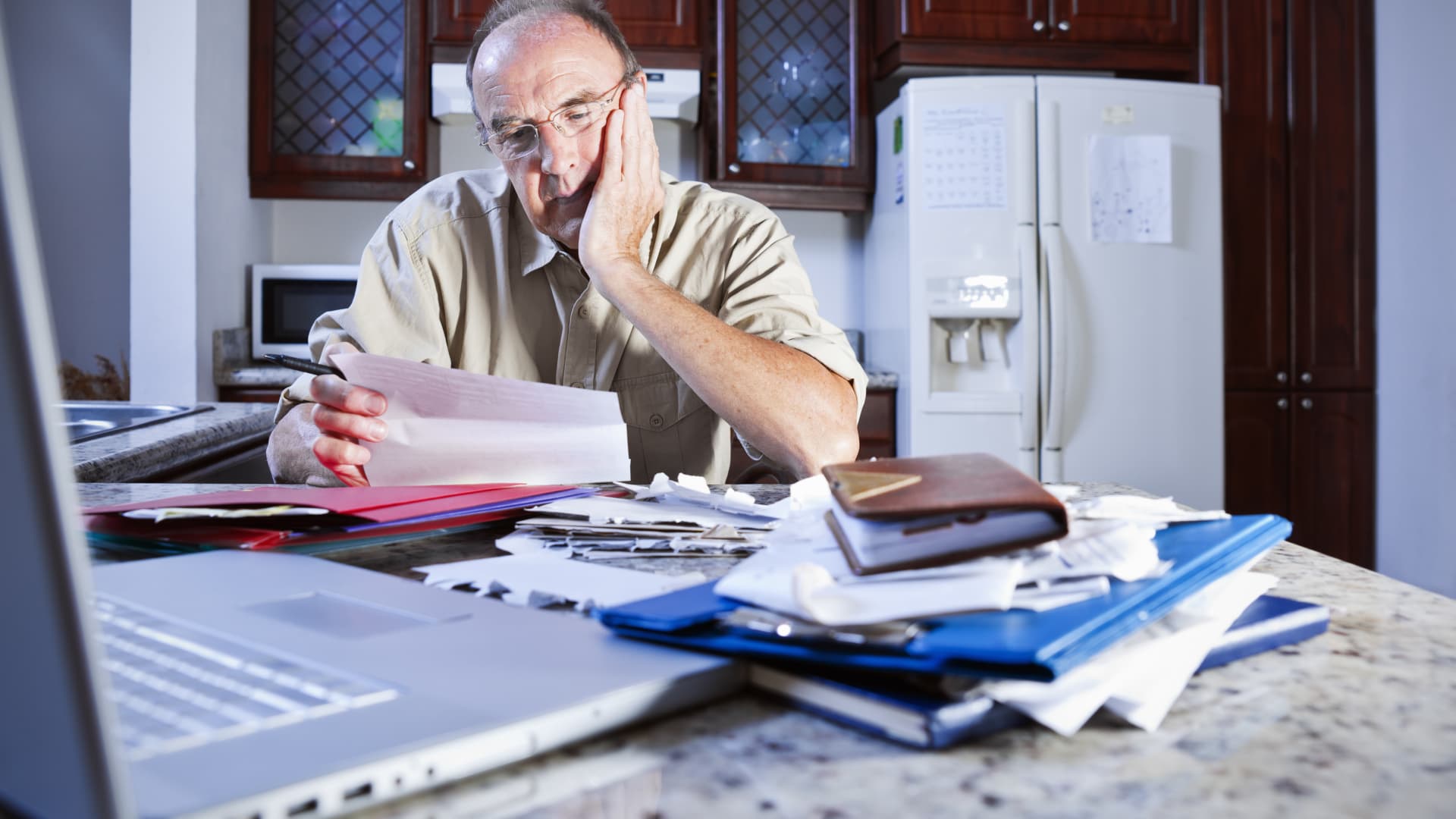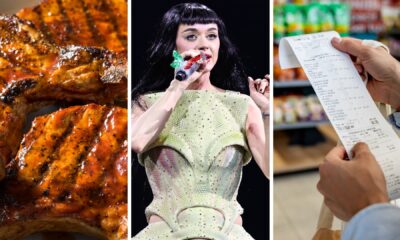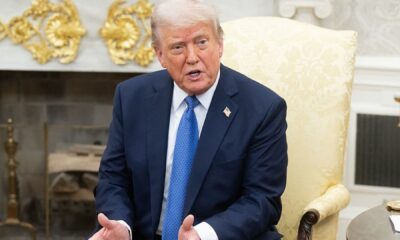Personal Finance
Mom who co-signed student loan for daughter fears losing her home
Published
9 months agoon

Kumikomini | Istock | Getty Images
In 2004, Sabrina Finch returned to school to become a nurse.
Her mother, Rebecca, was excited for Sabrina, then in her early 30s, to finally have a career. She’d watched for years as Sabrina struggled to get by working low-wage jobs, including in fast-food restaurants and factories.
As a result, when Sabrina took out a private student loan from Navient in 2007 to complete her nursing degree, Rebecca was happy to be the co-signer on the loan.
Both women have come to regret that decision.
Sabrina, who is now 53 and lives in Vinton, Virginia, said her life took many difficult turns in the last two decades.
She said she became resistant to treatments for her bipolar disorder and found it difficult to get out of bed on many mornings. Consequently, she fell behind on her bills.
In May, Navient excused Sabrina from her private student loan after she proved her disability left her unable to work. However, the company then transferred the loan to her mother.
Rebecca is now 85, with health challenges of her own, including cardiovascular disease and constant pain from a fractured hip. Several strokes have left Rebecca with speech and cognitive issues, Sabrina said.
Rebecca’s only income is her roughly $1,650 monthly Social Security benefit. There’s no way she can afford to pay down the loan balance, which is more than $31,000, Sabrina said.
“I’m worried they’ll take her house,” Sabrina said. So is Rebecca, she said.
Sabrina spoke on her mother’s behalf, given Rebecca’s extensive medical issues.
Rebecca Finch
Courtesy: Rebecca Finch
Paul Hartwick, vice president of corporate communications at Navient, a significant owner of private education debt, said it informed Finch in April that the loan would be transferred to her mother if she was removed from it.
“A co-signer for a loan is liable for the account if the primary borrower cannot or does not make payments on the loan,” Hartwick wrote in an email to CNBC.
Lenders require co-signer on most private student loans
The private student loan market is skyrocketing — and with it the number of family members and friends who are also on the hook for the debt as co-signers.
As the cost of higher education swells, the $130 billion private education loan industry has grown —more than 70% between 2010 and 2019, according to the Student Borrower Protection Center. Today, Americans owe more in private student loans than they do in past-due medical debt or payday loans.
Borrowers of private student loans are much more likely to be required to have a co-signer compared with other kinds of lending, said Hanneh Bareham, a student loans expert at Bankrate.com.
“There are other loan types that offer co-signers as an option to assist with getting approved or getting a lower interest rate, but many don’t require co-signers like some private student loan lenders do,” Bareham said.
Indeed, more than 90% of private student loans include a co-signer who is equally financially and legally responsible for the debt, according to an analysis by higher education expert Mark Kantrowitz.
“A co-signer is often required for a private student loan because the student borrower has a thin or non-existent credit history,” Kantrowitz said. “They are an unproven asset.”
But there are many financial risks and few safeguards for co-signers of private student loans, said Anna Anderson, a staff attorney at the National Consumer Law Center.
Pavlo Gonchar | Lightrocket | Getty Images
“It’s hard to predict how things will turn out for the student when they first take out the loan,” Anderson said. “Graduation is sometimes years down the road, and there is no guarantee that the student will be able to graduate at all.”
Nearly half of all borrowers ages 50 and up who co-signed on a private student loan ended up making a payment on the loan themselves, a 2017 AARP survey found.
“It’s truly an inter-generational problem,” said Persis Yu, deputy executive director at the Student Borrower Protection Center.
‘It’s very, very difficult to get off of the loan’
The U.S. Department of Education, which typically doesn’t require co-signers on its federal student loans, forgives the debt of borrowers who become permanently disabled or can prove they were defrauded by their schools. Federal student loans also die with the borrower.
In contrast, student loan forgiveness by private lenders is extremely rare, experts say.
Only about half of the lenders discharge the debt when the primary borrower becomes disabled or dies, according to Kantrowitz, who’s been tracking education loan data for decades.
We’ve seen how this can destroy families.
Anna Anderson
lawyer at the National Consumer Law Center
Even when a lender does grant a borrower relief, as Sabrina found, the debt then often falls on their co-signer, said Anderson, of the National Consumer Law Center.
“It’s very, very difficult to get off of the loan if you are a co-signer,” Anderson said. “We’ve seen how this can destroy families.”
Carolina Rodriguez, director of the Education Debt Consumer Assistance Program, or EDCAP, in New York, agreed.
“Based on my experience, co-signer release is virtually non-existent in practice,” Rodriguez said.
Indeed, the Consumer Financial Protection Bureau found in 2015 that private student lenders rejected 90% of co-signer release applications.
Her private debt has nearly doubled
In October, Sabrina was approved for disability benefits through Social Security because of her schizoaffective bipolar disorder. Another neurological issue she’s recently developed requires her to use a wheelchair most of the time.
“I really wanted to keep nursing, but my mental illness kept me from doing it,” Sabrina said.
The Education Department often forgives the federal student loans of borrowers who can document that they’re receiving Social Security disability benefits over a long period. Sabrina didn’t need to go through that process, because the Education Department canceled her federal student loan balance in October through its recent relief efforts for those who have been in repayment for many years. Her federal student loan debt was around $120,000.
Rebecca Finch’s house in Troutville, Virginia.
Courtesy: Rebecca Finch
But her private student loan balance has only grown.
Sabrina originally borrowed $17,600 from Navient in 2007; the loan balance is now more than $31,000, according to information provided by Hartwick. The variable interest rate is currently set at 10%.
Sabrina said Rebecca, who is now responsible for the debt, can’t afford the $312 monthly loan payment.
Rebecca worked low-wage jobs throughout her career, mostly as a cashier at a truck stop. Her mortgage payment, at around $635, eats up more than a third of her $1,650 monthly Social Security benefit.
“My mom barely makes enough to cover her basic human needs,” Sabrina said.
Sabrina said her worst fear is that the lender will come after her mother’s two-bedroom house in Troutville, Virginia. She said one of the callers from Navient mentioned that possibility to her. Rebecca’s house was built in the 1950s and has a leaking roof and no heat, among other problems that the family can’t afford to fix, Sabrina said.
“But it’s all she has,” she said.
Hartwick, of Navient, said he couldn’t comment on whether the lender discussed the possibility of a lien on Rebecca’s house.
“But I can say, in general, private student loans do not go into collections until after a period of delinquency,” Hartwick said. “And, like other loans, there’s a process, often lengthy, to take legal action toward repayment.”
My mom barely makes enough to cover her basic human needs.
Lenders of private student loans are incredibly aggressive with their collection tactics, said Anderson, of the National Consumer Law Center.
“We see drastic steps taken where the borrowers are sued, and get brought into court and end up with very costly judgments against them,” Anderson said. “This can result in liens being placed on their houses, having their wages garnished and bank accounts frozen.”
Hartwick said Navient recommended Rebecca apply to the company for a disability discharge herself.
Sabrina told CNBC she has informed Navient that her mother is ill. Sabrina submitted that application on behalf of her mother on July 26, and is waiting for a determination.
That didn’t stop Navient from continuing to contact Rebecca, Sabrina said.
“They are unrelenting even though they have the review in process,” she said.
Hartwick said borrowers can always contact the lender and share their communication preferences “or update their communication preferences online — including asking us to not call them.”
A father’s retirement at risk
In 2007, Kathleen Cullen began attending The French Culinary Institute, a for-profit school in downtown Manhattan, with dreams of becoming a chef. Her father, Ken, a union electrician, co-signed her nearly $30,000 private student loan from Navient.
“He was excited about the possibility, and looking to help me fast-track myself into a career,” said Cullen, now 41. “We couldn’t afford to do the traditional college route.”
Unfortunately, Cullen said, the nine-month education program fell far short of the world-class one she was promised by the school’s recruiters. Many of her classes were taught by recent graduates of the school and centered on simple knife and food safety lessons, knowledge she could have picked up online, she said.
“You wouldn’t expect a whole class to be on learning a basic French recipe like beef bourguignon,” Cullen said.
The International Culinary Center, formerly known as The French Culinary Institute, is no longer enrolling students, according to its website. It says it is now collaborating with The Institute of Culinary Education.
Former International Culinary Center students brought a class-action lawsuit against the center in 2014, alleging an “ongoing fraudulent scheme.” That lawsuit was dismissed in 2015. Rodriguez, of EDCAP, said the suit was likely settled out of court.
EDCAP is helping Cullen in her efforts to get Navient to cancel her debt. Cullen was not involved in the 2014 lawsuit, Rodriguez said.
“They promised high employment prospects, high quality teachers and courses, and it was a lie,” Rodriguez said of The French Culinary Institute. “The degree was worthless.”
“The Institute of Culinary Education entered into a licensing agreement with [The French Culinary Institute/ The International Culinary Center] in 2020 upon their closure,” Stephanie Fraiman Weichselbaum, public relations and communications director at the Institute of Culinary Education, wrote to CNBC in an email.
“We therefore cannot comment, as we have no records prior to that time,” Fraiman Weichselbaum said.
Cullen, who lives in New York City, said that because of the poor-quality education she received, she’s still working as a bartender and earns around $40,000 a year. That makes it difficult for her to meet her private student loan bill each month, she said.
Whenever Cullen falls behind, her father receives phone calls from Navient, she said.
“His phone is just going off the hook,” she said. “It puts a huge strain on our relationship.”
He was excited about the possibility, and looking to help me fast-track myself into a career.
Anderson, of the National Consumer Law Project, said parents who co-sign on student loans for for-profit schools are at additional risk.
“We have seen many instances of students and family members taking out private loans to cover expenses at for-profit institutions that have a history of poor outcomes for students, often leaving them further behind in terms of job prospects and financial stability,” Anderson said.
“This is different than when someone co-signs on a loan for something tangible that their loved one will benefit from right away, such as a car or an apartment,” she said.
Asked about Cullen’s case, Navient’s Hartwick reiterated that co-signers are responsible for the loans when borrowers don’t pay, adding that this is the case with many other types of debt.
“If an account is delinquent, we may contact both the borrower and co-signer,” Hartwick said.
Cullen said that despite her father saving for retirement for decades, he’s now worried her debt will upend his plans. The private student loan currently has a 15% interest rate, and the balance is nearing $77,000 today, more than double what Cullen originally borrowed, according to financial records reviewed by CNBC.
“He’s worked so hard to make sure he has a safety net, and the loan puts that in jeopardy,” Cullen said.
Her father declined to be interviewed but gave permission for his daughter to share their story.
Cullen is in the process of trying to prove to Navient that her school defrauded her. In such cases, the lender will consider discharging the borrower’s debt and releasing any co-signer, said Eileen Connor, director of litigation at The Project on Predatory Student Lending.
Navient provides a form specifically for borrowers seeking cancellation on the basis of school misconduct. However, Navient frequently rejects such requests, even when the federal government has agreed to forgive the student debt for that school, Connor said.
“What we’ve seen is a lot of denials that don’t make sense,” Connor said. “There’s just not an explanation.”
Hartwick declined to comment on Navient’s debt cancellation process for defrauded borrowers.
Borrowers who have asked a loved one to co-sign the debt have few options, Connor said.
“You have to keep paying, because you don’t want to ruin your mother’s credit,” she said. “They have borrowers trapped.”
You may like
Personal Finance
Social Security overpayment withholding rate drops to 50% for some
Published
53 minutes agoon
May 5, 2025
Fertnig | E+ | Getty Images
Just weeks after announcing a 100% withholding rate on new overpayments of benefits, the Social Security has slashed the rate down to 50% for certain beneficiaries.
Yet that clawback on monthly benefit checks may still cause a financial burden for individuals who are affected, experts say.
For new overpayment notices sent on or after April 25, the 50% default withholding rate will apply to so-called Title II benefits, which include retirement, survivors and disability insurance, according to an emergency message released by the Social Security Administration.
The withholding rate for Supplemental Security Income benefits remains 10%.
More from Personal Finance:
Should you wait to claim Social Security? Here’s what experts say
Americans more worried about running out of money in retirement than dying
Nearing retirement? These strategies can protect from tariff volatility
“Obviously, it’s better not to lose all of your income,” said Kate Lang, director of federal income security at Justice in Aging, a national organization focused on fighting senior poverty.
“But if you’re relying on your benefits to pay your rent or your mortgage and buy food, losing half of that income is going to be devastating and can still result in people becoming homeless,” Lang said.
How beneficiaries end up owing Social Security
Beneficiaries may owe the Social Security Administration money due to overpayments — when their monthly benefit checks are more than what they are owed. The erroneous payments can happen for a variety of reasons, such as if a beneficiary fails to report a change in their circumstances to the agency or if the agency does not process information promptly or enters errors in its data.
When the Social Security Administration determines a beneficiary has been overpaid, a notice is sent to request a full and immediate refund, according to the agency.
Beneficiaries typically have 90 days to request a lower rate of withholding, a reconsideration or waiver of recovery. If they do not make such a request within that 90-day window, the agency will withhold up to 50% of their benefits until the sum of the amount that was overpaid is fully recovered, according to the agency’s update.

The Social Security Administration had previously announced that it would increase the default withholding rate for overpayments to 100%. Under President Joe Biden’s administration, the default withholding rate had been dropped to 10% of a beneficiary’s monthly benefit or $10 — whichever was greater. Generally, the rate beneficiaries are subject to is based on the terms at the time they were notified.
“In the last 100 days, we’ve gone from as low as 10 [percent] to 100 and now to 50,” said Richard Fiesta, executive director of the Alliance for Retired Americans.
The 100% withholding rate was “ridiculously draconian and cruel,” Fiesta said. The Social Security Administration had said the change to that full recovery rate would generate about $7 billion in program savings in the next decade, based on estimates from the chief actuary.
Yet even with the default withholding rate cut in half, beneficiaries may still struggle financially.
“Losing 50% [of benefits] for a lot of people could put them into immediate economic hardship,” Fiesta said.
In most cases, it wasn’t the beneficiary’s fault that they were overpaid, Fiesta said. “They shouldn’t be put in a worse situation because of something they never caused in the first place,” he said.
‘A lot of discretion’ in negotiating repayment terms
While beneficiaries do have the ability to negotiate the payments, there is no guarantee they will be successful and the outcomes may vary, according to Lang.
“There are thousands of employees that individual beneficiaries are going to be dealing with to ask for a waiver or ask to negotiate a different repayment rate,” Lang said. “And those employees have a lot of discretion in what they decide.”
Beneficiaries who are dealing with overpayment issues also face long wait times to make an appointment to visit a Social Security Administration office, which can interfere with their ability to exercise the options available to them, she said.
The Social Security Administration did not respond to CNBC’s request for comment.
Personal Finance
Student loan collections restart for borrowers in default
Published
1 hour agoon
May 5, 2025
A person walks on campus at Muhlenberg College in Allentown, Pennsylvania, U.S. March 26, 2025.
Hannah Beier | Reuters
Borrowers face plan changes, long waits for help
Collection activity on federal student loans has mostly been paused for half a decade. During that period, there have been sweeping changes and disruptions to the lending system.
Millions of borrowers who signed up for the Biden administration’s new repayment plan, known as SAVE, were caught in limbo after GOP-led lawsuits managed to get the plan blocked in the summer of last year. Many of those borrowers will now have to switch out of a Biden-era payment pause and into another repayment plan that will spike their monthly bill.
In recent months, the Trump administration has eliminated the forgiveness provision from some student loan repayment plans.

It also terminated staff at the Education Department, including many of the people who helped assist borrowers. Now some student loan borrowers report waiting hours on the phone before being able to reach someone about their debt. (The Trump administration has told defaulted borrowers to contact the department for options on getting current.)
“The timing of the layoffs is unfortunate, given the need for borrowers to get help,” said higher education expert Mark Kantrowitz, who added that he’s heard from people stuck waiting on hold as long as eight hours to speak with someone at the department or their loan servicer.
Borrowers in default may see credit scores decline
Restarting collections while the federal student loan system is facing so much uncertainty “will further fan the flames of economic chaos for working families across this country,” said Mike Pierce, the executive director of the Student Borrower Protection Center.
In addition to garnished paychecks and benefits, the millions of borrowers who are already late on their payments may see their credit scores tank by as much as 129 points as the Education Department ramps up collection activity, VantageScore recently wrote.
Meanwhile, the Federal Reserve predicted in March that some people with a delinquency could see their scores fall by as much as 171 points. Credit scores typically range from 300 to 850, with around 670 and higher considered good.
Lower credit scores can lead to higher borrowing costs on consumer loans such as mortgages, car loans and credit cards.
“We’ve been seeing clients with delinquent accounts who reached out after noticing a drop in their credit scores,” said Carolina Rodriguez, director of the Education Debt Consumer Assistance Program in New York.
She said one client hasn’t made a payment on her student debt since last year because she can’t afford her $200 monthly bill.
“She’s making $45,000 and living in New York City,” Rodriguez said. “Every month, she’s in the red.”


Ethan Bianco, 17, waited right up until the May 1 deadline before deciding which college he would attend in the fall.
The senior at Kinder High School for the Performing and Visual Arts in Houston was accepted to several schools, and had whittled down his choices to Vanderbilt University and University of Texas at Austin. Ultimately, the cost was a significant factor in his final decision.
“UT is a much better award package,” he said. In-state tuition for the current academic year is $10,858 to $13,576 a year, which would be largely covered by Bianco’s financial aid offer.
More from Personal Finance:
Is college still worth it? It is for most, but not all
How to maximize your college financial aid offer
What student loan forgiveness opportunities remain under Trump
Vanderbilt, on the other hand, consistently ranks among the best private colleges for financial aid and promises to meet 100% of a family’s demonstrated need.
The school initially offered Bianco $35,000 in aid, he said. With that package, “it would be about $40,000 more for my family to attend Vanderbilt per year.”
However, he successfully appealed his award package and leveraged private scholarships to bring the price down further — and committed to Vanderbilt on National College Decision Day.
How cost plays into college choices
For most graduating high school seniors, the math works out differently. The rising cost of college has resulted in a higher percentage of students enrolling in public schools over private ones, according to Robert Franek, editor-in-chief of The Princeton Review.
“Currently, it is about 73% of the undergraduate population — but this year, with increasing uncertainties about financial aid and changing policies about student loans, it is very likely that number will go up,” Franek said.

Soaring college costs and looming student debt balances have pushed this trend, and this year, there are added concerns about the economy and dwindling federal loan forgiveness options. As a result, this year’s crop of high school seniors is more likely to choose local and less-expensive public schools rather than private universities far from home, Franek said.
Price is now a bigger consideration among students and parents when choosing a college, other reports also show. Financial concerns govern decision-making for 8 in 10 families, according to one report by education lender Sallie Mae, outweighing even academics when choosing a school
“Choosing a school is a personal and individual decision,” said Chris Ebeling, head of student lending at Citizens Financial Group. Along with academics and extracurriculars, “equally important is the cost,” he said. “That needs to be weighed and considered carefully.”
Carlos Marin, 17, on National College Decision Day.
Courtesy of AT&T
On National College Decision Day, Carlos Marin, a senior at Milby High School, also in Houston, enrolled at the University of Houston-Downtown. Marin, 17, who could be the first person in his family to graduate from college, said he plans to live at home and commute to classes.
“The other schools I got into were farther away but the cost of room and board was really expensive,” Marin said.
College costs keep rising
College costs have risen significantly in recent decades, with tuition increasing 5.6% a year, on average, since 1983 — outpacing inflation and other household expenses, according to a recent report by J.P. Morgan Asset Management.
Deep cuts in state funding for higher education have also contributed to the soaring price tag and pushed more of the costs onto students. Families now shoulder 48% of college expenses, up from 38% a decade ago, J.P. Morgan Asset Management found, with scholarships, grants and loans helping to bridge the gap.
Nearly every year, students and their families have been borrowing more, which boosted total outstanding student debt to where it stands today, at more than $1.6 trillion.
A separate survey by The Princeton Review found that taking on too much debt is the No. 1 worry among all college-bound students.
Incoming Vanderbilt freshman Bianco qualified for a number of additional private scholarships and even received a free laptop from AT&T so that he could submit the Free Application for Federal Student Aid and fill out college applications. He said he is wary of taking out loans to make up for the difference.
“I believe that student loans can be beneficial but there’s also the assumption that you’ll be in debt for a very long time,” Bianco said. “It almost becomes a burden that is too much to bear.”
Don’t miss these insights from CNBC PRO

DOGE downsizing, IRS commissioner switch complicate tax season

Social Security overpayment withholding rate drops to 50% for some

Student loan collections restart for borrowers in default

New 2023 K-1 instructions stir the CAMT pot for partnerships and corporations

The Essential Practice of Bank and Credit Card Statement Reconciliation

Are American progressives making themselves sad?
Trending
-

 Economics1 week ago
Economics1 week agoECB members say inflation job nearly done but tariff risks loom
-

 Accounting1 week ago
Accounting1 week agoAt Schellman, AI reshapes a firm’s staffing needs
-

 Economics1 week ago
Economics1 week agoAmericans are getting flashbacks to 2008 as tariffs stoke recession fears
-

 Economics1 week ago
Economics1 week agoTrump insists bond market tumult didn’t influence tariff pause: ‘I wasn’t worried’
-

 Economics1 week ago
Economics1 week agoChecks and Balance newsletter: Predictions for the Democrats’ future
-

 Personal Finance1 week ago
Personal Finance1 week agoAs Real ID deadline approaches, there are ‘workarounds,’ experts say
-

 Economics1 week ago
Economics1 week agoWater sommeliers say the simplest drink is the future of luxury
-

 Personal Finance1 week ago
Personal Finance1 week agoMany Americans are worried about running out of money in retirement
